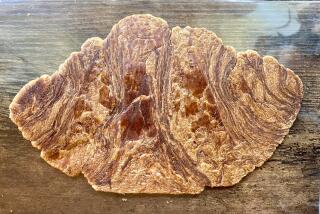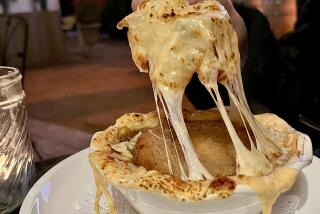High time for Paris’ great tearooms
Ever since Ladurée pâtisserie supplied the cakes for the 2006 period film “Marie Antoinette” — specifically for the guillotined heroine played by Kirsten Dunst — tea has become a near-obsession for Parisians. It’s a hedonistic, decadent, hourlong indulgence, a world away from the starchy 4 p.m. English ritual.
“Adding sugar, milk, English-style — this is not tea,” says Madame Yu Hui Tseng, whose Paris teahouse is the epicenter for refined palates. Indeed, French taste buds shudder at the idea of milk masking the delicate flavor of exotic, scented teas.
The French had tea first, in 1636, 22 years before it arrived in England. In Marie Antoinette’s day, the famous diarist of the time, Madame de Sévigné, wrote that court princesses sipped 12 cups a day, and in 1862 Louis Ernest Ladurée introduced the teahouse as an excuse for women to venture out alone.
The Paris tea rush has spawned a rash of sleek teahouses and revived forgotten gems. There are new Japanese, Korean and Russian houses, and classic French addresses such as Hédiard, Dalloyau and Mariage Frères are newly fashionable. Even Sorbonne intellectuals sipping Moroccan tea under the sprawling fig trees at the Paris Mosque have had to make way for a chic new crowd.
French women have always preferred a tisane as the last drink of the day. They claim it stimulates the kidneys, dissolves fats and speeds digestion.
The teas seem expensive (sometimes $10 a cup), but these are tea temples where you learn how to steep it properly, sit and sip for at least an hour and unwind in this relaxing, almost therapeutic ritual. But taking tea requires one sacrifice — lunch or dinner — because you can’t possibly add tea when the cakes are so very Versailles.
MARIAGE FRÈRES
Mariage Frères’ glossy black canisters with tea from 35 countries are exported to connoisseurs all over the world, but it saves the best for this tiny salon in the fashionable Marais. The mood is colonial Indochine: sunny yellow walls, potted palms and tables set with silver and linen.A waiter offers a choice of 500 teas (black, green, red, blue and white). In summer it serves enormous, stemmed bowls of frigidly cold tea like Tea sur le Nil ($9.62), a green tea flavored with citrus. It’s delicious with Full Moon ginger cake or Tibet tea panacotta ($13.75 each).
There are pretty gifts to buy, such as lacquered wood tea canisters in cyclamen pink, orange and teal blue. Before you leave, take five minutes to go upstairs to the tiny museum of 19th century weighing scales, tea chests and caddies.
.
LADURÉE
Ladurée’s emblematic creation is the sugary, round macaron — in 20 flavors. The old-is-new-again teahouse is a temple to Marie Antoinette. Do as Parisians do and go upstairs to the cushiony banquettes set against wood-paneled walls, mirrors and painted murals.How can you possibly have anything but the Marie Antoinette tea, which is Chinese tea infused with extracts of rose, jasmine, dried fruit and honey? And what would the queen have selected to eat? “St. Honoré à la Russe,” says a waitress in a floor-length apron. It’s a confection of filo pastry, rose petal custard, Chantilly cream, miniature éclairs, raspberries and rose petals.
If you choose macarons with your tea (a selection of four is $8.40) the favorites are violet, raspberry, rose petal and orange blossom.
8.30 a.m. to 7 p.m. Mondays to Saturdays; 10 a.m. to 7 p.m. Sundays. 16 Rue Royal, 011-33-1-42-60-21-79, www.laduree.fr.
DALLOYAU
Dalloyau, in the heart of chic shopping, has been around since 1802. The fashion crowd loves it because teas are carefully matched to each season, and the cakes are iconic.Dalloyau was the first pâtisserie to put gold leaf onto chocolate-topped cakes and the chocolate pyramid, Le Louvre ($6.25), is named for the entrance to the museum. The first-floor tearoom shimmers with turquoise silk cushions against chocolate brown, and on a midsummer’s day the aromatic Fruit Tea is delicious: flavored with grapefruit, orange and rose oils ($9.62). Choose a St. Honoré pastry with it.
If you don’t like fragrant tea, servers will suggest Darjeeling, the rich “Champagne of teas.” This may be the freshest tea in Paris; a tiny sachet is filled with leaves to your order, then knotted at your table.
8:30 a.m. to 9 p.m. daily. 101 Faubourg Saint-Honoré, 011-33-1-42-99-90-00, dalloyau.splio.fr.
HÉDIARD
Hédiard is the unashamedly elitist Paris grocer where tea is taken on the first floor — as tradition demands. The atmosphere is reminiscent of ‘40s shipboard life with zebra print upholstery, oodles of bamboo and towering vases of orchids. Hédiard overlooks the Madeleine and is good for a business conversation.The waitress will tell you not only the caffeine content of your tea, but also how long to steep it for best results. The famed tea is the energizing Mélange Hédiard ($11), a black tea with bergamot and sweet orange oils. Fans of green tea should chose White Monkey, an afternoon tea.
With this address, it’s hardly surprising that the most popular cakes are the lighter-than-air madeleines.
9 a.m. to 10 p.m. Mondays to Saturdays. 21 Place de la Madeleine, 011-33-1-43-12-88-88, www.hediard.fr.L’ESPACE HAN-SEINE
Lim Joon-seo opened his edgy, contemporary teahouse last year, naming it after the rivers that run through Seoul and Paris. It’s a tiny cross-cultural hub, pandering to young Parisians.On a steamy summer day they sip watermelon-pink omija iced tea, floating with miniature stars cut from fresh, iced pear. Nothing quite quenches a summer thirst like this, unless it’s the moody pink, frigidly cold sujongkwa tea made with crushed raspberry, ginger and cinnamon.
The traditional teas include nok (green tea), nok special (organic green tea), insam (ginseng) and taetchu (red date). Pink, green and lemon rice pastries (parans) and bean paste jellies (kyungda) cost $1.37 to $2.06. Teas are $4.12 to $9.62.
11 a.m. to 7:30 p.m. Mondays to Saturdays. 32 Rue Monsieur le Prince, 011-33-1-40-46-80-40.
LA MAISON DES TROIS TEAS
When Madame Tseng returns to Paris from checking plantations in China, the city’s Michelin-starred chefs, Pierre Gagnier and Alain Senderens are among her first customers (all serve her tea in their restaurants). She conducts a tasting for them, producing rare teas that date from 1890, others that sell for $1,199 a kilo. She opened her teahouse in 1994, filling it with antique Chinese furniture, 17th century Qing dynasty bowls and a wall of beautiful canisters painted with calligraphy.Her staff (including Fabien Maiolino, who comes from the wine industry) will guide you on selecting from 400 black, red, blue-green, green, white or yellow teas. You’ll be taught to enjoy tea for the evaporating scent as well as the taste. Tea is from $9.62.
11 a.m. to 7:30 p.m. Mondays to Saturdays. 1 Rue Saint-Medard, 011-33-1-43-36-93-84. Closed in August.
THE PARIS MOSQUE
Think Casablanca, not Paris. Musicians and film crews while away hours in the Moorish Arabic tearoom of La Grande Mosquée de Paris or its pretty mosaic-tiled summer gardens.The mosque was built in 1922 for Paris’ Muslim population, and the tea ritual has been an exotic escape ever since. On a cold winter’s day, the interior is snug, with red velvet banquettes and brass tables beneath walls decorated with murals of songbirds.
Fresh mint leaves are steeped in boiling water, sugared and served in tall hand-painted glasses ($2.75). Pastries ($5.50) include honey-drenched Moroccan specialties made with pine nuts, almonds and dried fruits.
9 a.m. to 11 p.m. 1 Place du Puits de L’ermite (the entrance to the teahouse is at Rue Geoffrey-St-Hilaire and Rue Daubenton.) 011-33-1-43-31-38-20, www.mosquee-de-paris.org.
More to Read
Sign up for The Wild
We’ll help you find the best places to hike, bike and run, as well as the perfect silent spots for meditation and yoga.
You may occasionally receive promotional content from the Los Angeles Times.






